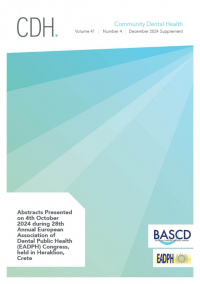Professional careers of graduates from one UK dental school
Authors:
M.A.H. Tomson
D.A. White
A.J.Morris
doi: 10.1922/CDH_2889Tomson05
Abstract
Aim: The aim of this study was to consider reported working patterns of dentists and retention of the dental workforce. Method: Three cohorts of dental graduates from the University of Birmingham (n=505) were tracked using the General Dental Council (GDC) register to assess retention of the workforce. A questionnaire was sent to these graduates to explore changes in working patterns over time and to investigate the factors which had influenced their choice of job location. Results: A high proportion (90.9%) of the dental graduates included in this tracking exercise were found on the GDC register on the census date. A slightly higher proportion of female graduates (10.3%) than male graduates (8.0%) could not be traced on the current register (p=0.37). A change in working patterns over time was demonstrated, with more general dental practitioners reporting a shorter working week. ‘Availability of jobs’ was the factor reported by most respondents to be important in determining job location. Conclusion: This study provides evidence of changing work patterns over time. Furthermore, although the majority of the study sample remained on the GDC register, there appeared to have been a gradual loss of subjects from the dental workforce over time. Changes such as these may affect the provision of services and the impact of investment in training. Further research in this area is warranted.
Key words: dental manpower, distribution, career mobility, geographic location, employment status, United Kingdom
Download
Other articles in this issue
| Article |
Pages |
Access |
|
|
Editorial - Population based health and care: what does the new dental professional need to know?
Authors:
I.G. Chestnutt
|
194-194 |
|
Download
|
|
Dental Public Health in Action - The use of dental therapists as examiners in dental epidemiological surveys
Authors:
R.S. Patel, A.J. Sprod, P. Harwood, C.S. Drugan
|
195-197 |
|
Download
|
|
A service evaluation of patient pathways and care experiences of dentally anxious adult patients
Authors:
J. Porritt, S.R. Baker, Z. Marshman
|
198-202 |
|
Download
|
|
Assessment and validation of the oral impact on daily performance (OIDP) instrument among adults in Karnataka, South India
Authors:
B.M. Purohit, A. Singh, S. Acharya, M. Bhat, H. Priya
|
203-208 |
|
Download
|
|
The dental health of 5 year-old children living in Damascus, Syria
Authors:
M. Dashash, A. Blinkhorn
|
209-213 |
|
Download
|
|
Oral impacts and their association with tooth loss in Sri Lankan adults
Authors:
R. Perera, L. Ekanayake
|
214-218 |
|
Download
|
|
Oral Health Related Quality of Life among Older Adults in Central China
Authors:
Y. Zhou, M. Zhang, H. Jiang, B. Wu, M. Du
|
219-223 |
|
Download
|
|
High levels of periodontal disease among the older adult population in San Juan, Puerto Rico
Authors:
M. Montero-Aguilar, F.Muñoz-Torres, A.R. Elías-Boneta, B. Dye, K.J. Joshipura
|
224-228 |
|
Download
|
|
Caries in five different socio-economic clusters in Örebro county
Authors:
G.Ekbäck, C.Persson
|
229-232 |
|
Download
|
|
Root caries in 35-44 and 65-74 year-olds in Turkey
Authors:
S. Gökalp, B. Güçiz Doğan
|
233-238 |
|
Download
|
|
Dental anxiety levels in British servicemen and women
Authors:
G.P. Grimshaw, C.A. Boyle, T. Newton
|
239-242 |
|
Download
|
|
Sexual correlates of gagging and dental anxiety
Authors:
N. Uziel, G. Bronner, E. Elran, I. Eli
|
243-247 |
|
Download
|
|
Oral hygiene education in adolescence based on the Precaution Adoption Process Model
Authors:
J. Aleksejūnienė, V. Brukienė
|
248-251 |
|
Download
|
|
Professional careers of graduates from one UK dental school
Authors:
M.A.H. Tomson, D.A. White, A.J.Morris
|
252-256 |
|
Download
|
Subscribe
Online
(Single user only)
£150
Institution Online
(IP address validation)
£250
Back issues may be obtained from the publisher
Consider recommending subscription to your institution's library
You can view Open Access papers without a subscription.




